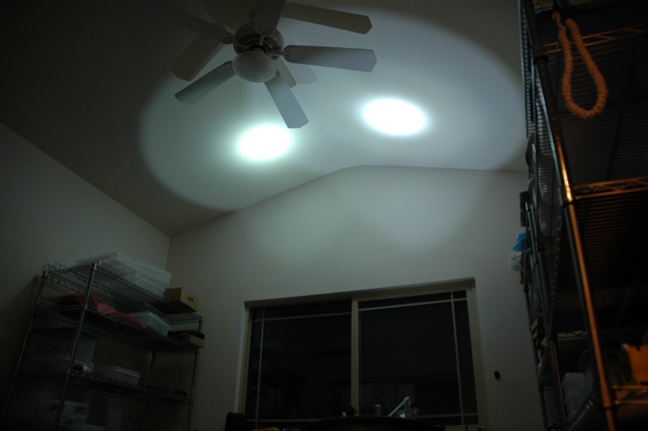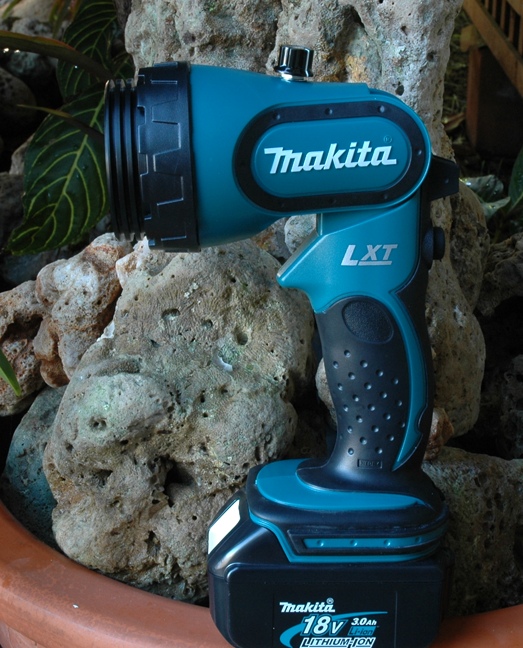
Cree 7090 XR-E LED in initial prototypes and some observations:

Above is a Ti "flood" PD using the.650 MCPCB with XR-E and no secondary optic. Also shown is the XR-E on MCPCB as well as one dropped into a proto "E" screw/can.
This light measures 3 lumens driven at 17 mA and 82 lumens driven at 522 mA. The flux measurement is probably about 10 - 15% high.

The light above is a Ti proto McRee-XR-E19 consisting of a 19 mm reflector and driven by a NexGen700 on single CR123. It measures 115 lumens out the front end and again, this measure is likely 10-15% higher than true. The light measures about 2500 lux at 1 meter.

The ceiling bounce beam shot above has a 27LT (UX1K) driven at 917 mA on the left and the XR-E19 on the right. This 27LT was measured by a lab at 68 lumens and I measure 69 lumens with it as it is introduced to my integrating sphere. I have a 27LT modified with another Cree XR-E (DB917) sample and it measures 110 lumens in my integrating sphere and measures 5500 lux at one meter.

With the non lambertian beam distribution and relatively narrow viewing angle of the XR-E, it behaves differently than Luxeon does when coupled with an optic. The deep 19 mm reflector does a good job of catching a fair amount of the output but the direct or spill portion of the beam is still quite strong and intense. It was difficult to find a Luxeon based light with a similar beam pattern and I believe what comes closest is the SF-L6 that uses a Luxeon 5W LED in a larger diameter but also deep reflector. In the beamshot above, the XR-E19 is on the left and a L6 on the right. I tried to place the light sources equal distance from the wall, about 3 feet away. This particular L6 measured 2050 lux at one meter. I can't introduce the large L6 to my integrating sphere but from ceiling bounce tests as well as outside comparisons, the XR-E19 has a brighter spot and spill beam with seemingly more flux. The spill angle of the XR-E19 is slightly narrower than that of the L6 but the beams of the two lights are very similar in size and distribution.
A chopped down version of the 19 mm reflector was tested in a Ti proto PD:

A modified 27L reflector was also installed with an XR-E in a Ti 27 Proto:

Both are respectable in their own right.

Neither are as effective, in my opinion, in terms of all around beam distribution as the A19-XR-E.
************
With a full moon that had not yet spilled into the back yard, some beam shots were taken with the camera on manual and the distance from light to pine tree is 33'.
First light is a Ti PD with a Luxeon UYAJ bin LED:

Next up is the SureFire L6 with Luxeon 5W LED:

And last, is the A19-XRE proto:

The lights are placed on a porch rail post and visible in the lower right of each image. The Cree XR-E LED has a "ghost" image from the dome and this manifest as a slightly noticible ring of light beyond the obvious spill of light from the die itself. This is evidenced by a white pot on the ground to the left. In the XR-E beam shot, this pot is obviously out of the spill portion of the beam and yet is illuminated rather well; almost as well as it is illuminated by the spill from the Ti PD. To the left of the pine tree there is a tall rock retaining wall. It's details can be seen in the spill of the XR-E beam.
Planed small production titanium mCree Ti-XR19 shown on Ti clickie pak:

This light has a high level current output of approximately 525 mA from GDx2 driver. It is very comperable to the SF L6 as evidenced in daytimebeam shot below:

The SF L6 is itself a viable host for the XR-E LED and it is compared to a stock L6 below. The L6XR has a DB917 driver replacing the stock ~900 mA driver of the L6:

L6XR mod is on right in these images.

Because the XR-E has a reported narrow viewing angle of 75 degrees, it seemed that the LED could be oriented perpindicular to the Z axis of a parabolic reflector section in such a reflector where its viewing angle would be completly visible to the reflective surface and not shaddowed by itself. A "SideShooter" configuration:

Multiples of the idea in an OverUnder configuration:

And given the fact that only the upper 75 degrees of the reflector are of prime consideration, a 120 degree section of a parabolic surface covers the needs and a 3 Shooter could be considered:

A triangular pedestal, relieved for LED lead connections, is host to three of the Cree XR-E LED's.
Yet to be visited, a 4 shooter would provide 90 degrees of reflector to each of the 4 LED's. A 4 sided pedestal would add to the overall diameter of the package but might also aid in assembly as well as thermal relief of the LED's.
As luck would have it and not by intentional design, The "3 Shooter" reflector and pedestal sink drop right into a Mag 3D with plenty room for a Shark boost converter:

The converter was adjusted to allow a maximum of 3amps in at 3 volts in. I don't know the resulting drive level to the LED string but would guess it is near the recomended 700 mA. I measured 8000 lux at one meter for this package (behind the stock plastic window).
Below is a McR-17XR reflector designed for the XR-E LED. The reflector has an OD matching that of the MCPCB and it has a centering flange on the rear that overlaps the lens retainer of the LED providing for a bonding mount if desired. It also has an O-ring groove for reflector retension in a bore application.

SureFire M6 modified with a 7up of 17mm XR's driven in series at 350 mA by a "Shark" driver of Dat2zip's:


Beam shot comparison of the Mag 3shooter (top) with this 7up (bottom):

Original PD modified to host XR-E and 17XR reflector:

An over/under side shooter study where there is no heat sink sandwiched between the LED's:


The brass pedestal has a milled pocket to accept two of the XR-E LED's back to back. They are wired in series and the aft end of the sandwich is recessed in the pocket with solder paste between the LED's and in the brass pocket. The electrical connection of the two LED's includes the pedestal and reflector essentially. I used a SF nitrolon G2 power pak to keep this connection from being common to the ground path. I ground off the via connections of one of the LED's on the top solder pad to break its electrical connection from the bottom side and to open the "loop" for lead inputs to the two LED's. Since the apparent image of these LED's is essentially at their very base, pairing the two like this allowed for experimantation in a single reflector and not two half canopies seperated by the thickness of a heat sink plane. The beam consists of a unified spot and two secondary flares from the LED's:

This "bow tie" beam can be oriented vertical or horizontal:

The string is driven at 700 mA and 10,000 lux was measured at one meter. If the pedestal is backed out of the reflector a bit, a larger and less intense single spot beam can be formed. This was the case with the 3-shooter shown above.
Makita 18V Li-Ion flashlight mod:




This light uses a Wayne Yamaguchi "Shark" boost converter and has a pot added for some output level control. On a freshly charged battery, the output can be varied from 1100 lux to 19,000 lux (one meter and measured without a window in place). If the battery voltage does drop down to 18 volts, the dimmer can be used to take the output much lower. The aluminum base weighs 3/4 lb and provides reasonable thermal mass for the LED's but not enough for full power for extended run times.
Directory of some beam shot pairings
(Nikon D70 manual exposure F9, 10 seconds: 18 mm lens; 33' to tree)